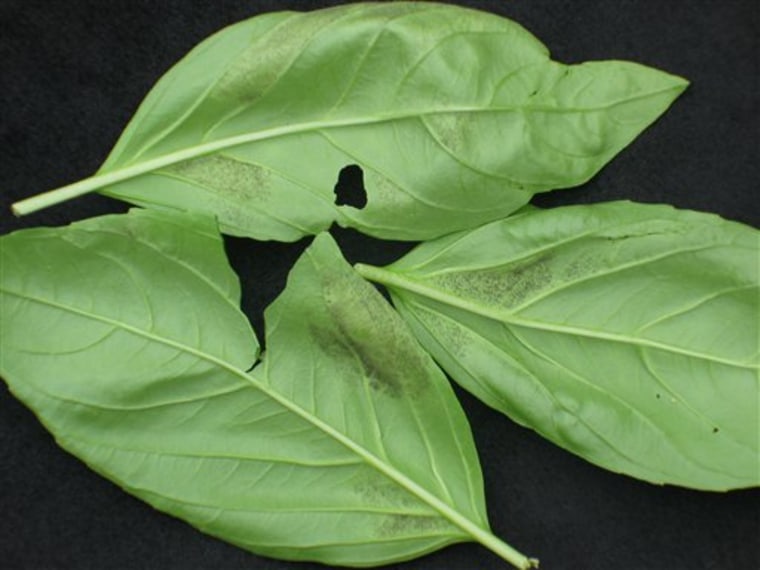A fungus spreading among the nation's basil crop may leave lovers of Italian and Thai food feeling a bit bland.
Basil downy mildew first surfaced in the U.S. around 2007 and is slowly but surely ruining the herb at spots across the country. Hardest hit areas are on the East Coast but it also has been found as far west as California.
For growers, the fungus can be devastating.
"We destroyed all our crop this year," said Francesco DeBaggio of DeBaggio's Herb Farm in Chantilly, Va. "We killed about 6,000 plants, or about $18,000 worth of plants."
DeBaggio said he first noticed it in May and didn't realize what it was. Once he determined it was downy mildew he decided to destroy his crop.
"It's huge for us," he said. "We're small so it's fairly significant. We would have sold 100 percent of those that were destroyed."
Basil is a commonly used to make pesto and tomato sauce and is a popular ingredient in Italian and Thai recipes. It's also often used in salads or sprinkled on tomatoes.
Margaret McGrath, an associate professor of plant pathology at Cornell University, said the fungus is likely more of a problem for home gardeners and herb farmers who may not have access to fungicides that are available to larger commercial growers.
"We think it's moving around each year, surviving over the winter and then moving north during the summer," McGrath said.
The relatively recent emergence of the fungus means many growers don't know about it, McGrath said.
"If you don't know what you have, you may not be responding correctly," she said.
In some cases, growers may think the yellowing leaves indicate the plant needs more fertilizer.
"And that's not going to help at all," McGrath said.
She said areas of shade and high humidity seem to be more susceptible to the fungus and that gardeners can help control it by spacing the plants further apart and planting them in areas that get more sun.
It is carried by spores that travel through the air, which means "it has the potential to go almost anywhere," McGrath said.
The spores are a gray or purplish color. Affected leaves begin to yellow but quickly turn brown before they die, McGrath said.
Downy mildew fungi have been around for years, with different forms affecting different plants and vegetables, but the downy mildew affecting basil is new, McGrath said.
It takes about two weeks from the time the plant is infected to when the fungus first appears, and DeBaggio said that means some growers may be selling infected plants without knowing it.
"They can't see it until it's too late and that plays a huge role in keeping the disease from being controlled better," DeBaggio said.
Margie Pikarsky, owner of the organic Bee Heaven Farm in Redland, Fla., said she has had problems growing basil since 2008. Until she recently heard of the fungus, she didn't know it was to blame for her failed crop.
At first she and other farmers thought there was a problem with the seed. The next year she blamed cold weather. She switched seed sources and the weather warmed but the herb still would not grow.
"We had no way of confirming any (cause of the problem), all we knew was we had no basil," Pikarsky said.
The fungus, which poses no risk to human health, could have the biggest impact on the market for fresh cut basil.
"When you harvest it and turn it into pesto, no harm no foul because no one will know the difference," DeBaggio said. "When you sell leaves that aren't possibly green — I can't sell something that's imperfect. If there is any visible damage, it reduces the potential it can be sold."
So far, McGrath said the problem isn't so bad that it has cut into supplies or caused prices to rise.
George Ball, chief executive officer of Warminster, Pa.-based Burpee Seeds, said it's important for people to realize the blight is manageable if precautions are taken, such as spreading plants out and putting them in sunnier locations.
Ball also said there are some varieties of basil, such as purple ruffles basil, that appear to be more resistant to the fungus.
"Try darker leaf varieties," he said.
McGrath agreed that some darker leaf and spice varieties have had less disease in variety comparisons.
For DeBaggio, who grows some specialty varieties, the fungus raises concerns about next year's crop. And he's decided against trying to grow more basil this year.
"We're just not going to take any chances," he said. "To have another season like this, that would put us out of business. We couldn't survive that again.
"Once you ruin your reputation, you can't get it back."
